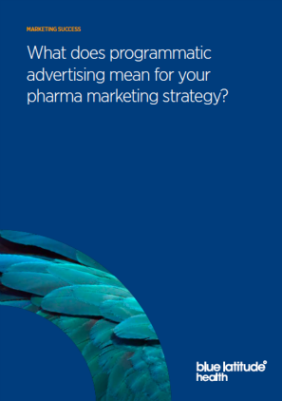What does programmatic advertising mean for your pharma marketing strategy?
January 17, 2018 | content strategy, digital marketing, marketing strategy, online advertising, programmatic advertising
Senior Associate Consultant Jiayi Chen explains the benefits and pitfalls of programmatic advertising and reveals how it can impact return on investment in your marketing campaigns.
In the last few years, programmatic advertising has become one of the most popular topics in digital marketing. A study by Econsultancy reveals almost two-thirds of marketers (62%) are using programmatic advertising for brand campaigns, as opposed to traditional direct response.According to a study from the Interactive Advertising Bureau, programmatic ad revenue in the US reached $10.1bn in 2014, accounting for 20% of total online ad revenue. This figure is likely to grow with eMarketer estimating a programmatic display ad spend will reach $33 billion this year and will hit $46 billion by 2019.
However, the pharmaceutical industry is falling behind. Peter Niemi, Partner at MDC Advertising estimates programmatic advertising accounts for a mere 4% to 5% of the digital ad spend in pharma, as opposed to other industries, which typically spend 50% to 75% of their budgets on this technology.
In the US, programmatic advertising in the healthcare sector is growing faster than in other parts of the world. Regulations state only direct-to-consumer (DTC) ads are allowed in the US and New Zealand follows a similar policy.
These adverts have been used in the key disease areas of cancer, allergies, dermatology, smoking cessation, and dental care, with pharmaceutical companies, hospital systems, medical devices, clinical trial and insurance companies targeting healthcare professionals (HCPs).
Regulatory requirements make programmatic advertising in healthcare more challenging in other countries. Outside the US, programmatic advertising is predominantly used in non-promotional areas, such as disease awareness campaigns and service-related content. This article is developed with a focus on using programmatic advertising in the US.
What is programmatic advertising?
Programmatic advertising, or programmatic media buying, is the algorithmic purchase and sale of advertising space in real time. During this process, bidding system software is used to automate the buying, placement, and optimisation of media inventory. Automating the process means it can be carried out instantly without relying on the human touch, manual insertions or manual trading.
With programmatic advertising, marketers and brands can tailor a specific piece of content to the right audience, at the right time, in the right context. The programmatic advertising system targets audiences, at scale, by matching behavioral data such as browsing history, which is collected by cookies. In this way, marketers can deliver precisely personalised messages, resulting in more efficiently targeted campaigns.
Programmatic advertising in pharma
Although the healthcare and pharma sectors have been slightly slower to capitalise on the programmatic advertising trend, the tool has great potential to help pharma marketers deliver highly targeted and personalised communications to customers.
With the use of data, pharmaceutical marketers can be far more targeted in their segmentation, choosing their audience by geography, psychology, and behaviour. This granular approach leads to a more efficient use of cookies for real-time bidding and trading. Pharma marketers can also use a third-party provider to track the cookies, saving further time and resource.

Download the full article from Blue Latitude Health
This content was provided by Blue Latitude Health




